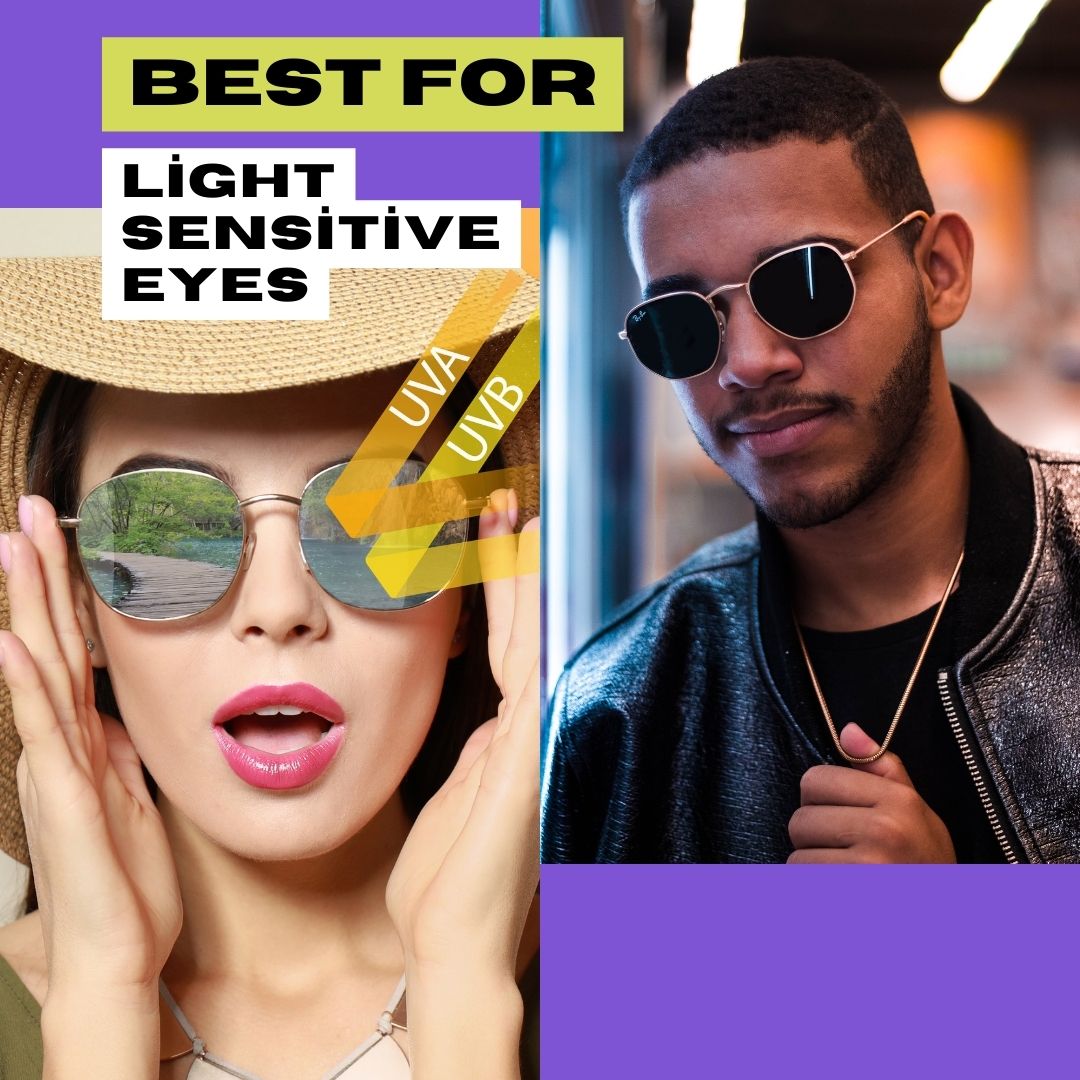How Should Sunglasses Fit – Discover the Secrets to Finding the Right Fit
Ever wondered how should sunglasses fit? Well, it’s simple – if your sunglasses slide down your nose faster than an ice cream cone on a sunny day or pinch your temples like a strict teacher’s disapproving glance, they definitely don’t fit right!
Finding the perfect pair is like Goldilocks searching for the right porridge—not too loose, not too tight, but just right. Because, let’s be honest, the only thing worse than squinting in the sun is the constant battle to keep your sunglasses from falling off.
But there is more to how should sunglasses fit you than meet the eyes. So, let’s get into the detailed answer to your question, “How should sunglasses fit”
How Should Sunglasses Fit
Good sunglasses fit means your sunglasses should hug your face gently, without squeezing your temples or slipping down your nose or leaving red marks. They should shield your eyes completely from the sun’s harmful rays, and look effortlessly.
Essentially, your sunglasses should feel like a natural extension of yourself, offering both style, comfort and protection.
The Best Sunglasses
While there are many sunglasses out there, they are not created the same way. So, here are the best sunglasses for men and women:
|
|
|
|
Features of Sunglasses that Fit Correctly
A pair of sunglasses that fits correctly should exhibit the following characteristics:
- Snug but Comfortable: Sunglasses should fit securely on your face without causing discomfort or pressure points. They should stay in place even when you move your head.
- Complete Coverage: The lenses should fully cover your eyes, providing ample protection from the sun’s harmful rays. Your eyelashes shouldn’t touch the frame.
- Balanced Weight Distribution: The weight of the sunglasses should be evenly distributed between the nose and ears. This prevents discomfort and ensures a stable fit.
- Proper Alignment: The lenses should be centered on your eyes, with the upper frame sitting below your eyebrows. This optimizes vision and prevents distortion.
- Adjustable Nose Pads: Many sunglasses feature adjustable nose pads. This lets you customize the fit to your nose shape and bridge width for maximum comfort.
- Correct Temple Length: The temples should fit comfortably behind your ears without being too tight or loose. They should extend to the appropriate length for your head size without pressing against the sides of your head.
- UV Protection: Beyond fit, ensuring your sunglasses provide 100% UV protection is crucial for eye health. Properly fitted sunglasses should block UVA and UVB rays completely. Check for labels or certifications indicating full UV protection.
Proper Fit and Sizing for Sunglasses
A well-fitted pair of sunglasses should enhance your appearance while providing optimal protection for your eyes. Here’s what to look for:
Measurements and Attributes of a Well-Fitted Pair
1. Bridge Width
Measurement: The bridge width typically ranges from 14mm to 24mm.
Fit: The bridge should rest comfortably on the nose without pinching or leaving gaps. A well-fitted bridge ensures that the sunglasses stay in place and do not slide down.
2. Lens Width
Measurement: Lens widths generally vary from 40mm to 60mm.
Fit: The lenses should fully cover your eyes and provide ample coverage to protect against UV rays. Bigger lenses are always better than smaller ones.
3. Lens Height
Measurement: The height of the lenses usually ranges from 30mm to 50mm.
Fit: Proper lens height ensures that the sunglasses cover your eyes completely, offering protection from sunlight coming from different angles.
4. Frame Width
Measurement: Total frame width typically falls between 120mm and 150mm.
Fit: The frame width should align with the width of your face. Frames that are too wide will slide down, while those that are too narrow will pinch and cause discomfort. The frame should be slightly wider than your face for optimal coverage and fit.
5. Temple Length
Measurement: Temple lengths usually range from 120mm to 150mm.
Fit: The temples should comfortably wrap around your ears without pressing too tightly. They should be long enough to provide stability but not so long that they cause the frames to slide forward. Temples that are too short can cause discomfort and inadequate support.
6. Arm (Temple) Fit
Measurement: The arms should be long enough to extend from the frame, over the ears, and rest comfortably behind them. Temple lengths vary but commonly range from 135mm to 145mm.
Fit: The arms should fit snugly around your ears without causing pressure points. They should be straight or have a slight curve to follow the natural contour of your head, ensuring the sunglasses stay securely in place during movement.
7. Frame Material and Weight
Attribute: Lightweight materials like titanium, acetate, or high-quality plastic enhance comfort, especially for extended wear.
Fit: Lightweight frames reduce pressure on the nose and ears, preventing discomfort and marks. Durable materials also ensure longevity and maintain the shape of the sunglasses.
8. Adjustable Features
Attribute: Adjustable nose pads and flexible temple tips.
Fit: These features allow for a customizable fit, accommodating various face shapes and sizes. Adjustable nose pads help in achieving a secure fit on the bridge of the nose, while flexible temples provide comfort and stability behind the ears.
Steps to Determine the Right Fit
Measure Your Face
- Use a ruler or measuring tape to measure the width of your face from temple to temple.
- Measure the bridge of your nose to determine the ideal bridge width.
Try On Different Sizes
- Experiment with different frame widths, lens sizes, and temple lengths to find the most comfortable and secure fit.
- Pay attention to how the sunglasses feel on your nose and behind your ears.
Check for Full Coverage
Ensure the lenses cover your eyes completely and provide adequate protection from sunlight entering from different angles.
Test Stability
Move your head in different directions to check if the sunglasses stay in place without slipping or feeling too tight.
Face Shapes and Sunglasses Styles
Choosing the right sunglasses that complement your face shape can enhance your overall look and ensure a comfortable fit. Here’s a guide to help you select the best styles for various face shapes:
1. Oval Face Shape

Characteristics: Balanced proportions, slightly wider cheekbones, gently curved jawline.
Recommended Styles: Almost any style works well with an oval face. Consider aviators, wayfarers, and oversized frames.
- Aviators: Their teardrop shape complements the balanced proportions.
- Wayfarers: Classic and versatile, these add definition to the face.
- Oversized Frames: Enhance the natural symmetry and add a touch of glamour.
2. Round Face Shape

Characteristics: Full cheeks, rounded chin, equal width and height.
Recommended Styles: Angular and geometric frames add definition and structure. Rectangular, square, and cat-eye styles work well.
- Rectangular Frames: Lengthen the face and create a slimming effect.
- Square Frames: Provide contrast and add angles to the soft features.
- Cat-Eye Frames: Lift the face and add a touch of elegance.
3. Square Face Shape

Characteristics: Strong jawline, broad forehead, and wide cheekbones.
Recommended Styles: Round and oval frames soften the angular features. Aviators and round sunglasses are ideal.
- Round Frames: Soften the strong jawline and add balance.
- Oval Frames: Complement the angular features and provide a harmonious look.
- Aviators: Add curves and soften the overall appearance.
4. Heart Face Shape

Characteristics: Wider forehead, high cheekbones, narrow chin.
Recommended Styles: Bottom-heavy frames, aviators, and round frames balance the face. Avoid top-heavy frames.
- Bottom-Heavy Frames: Add width to the lower part of the face.
- Aviators: Their teardrop shape balances the narrow chin.
- Round Frames: Soften the wider forehead and create a harmonious look.
5. Diamond Face Shape

Characteristics: Narrow forehead and jawline, wide cheekbones.
Recommended Styles: Oval and cat-eye frames enhance the cheekbones and soften the overall look. Avoid narrow frames.
- Oval Frames: Complement the wide cheekbones and narrow features.
- Cat-Eye Frames: Highlight the cheekbones and add a touch of flair.
- Rimless Frames: Minimize the width of the cheekbones and provide a balanced look.
The Bottom Line On How Should Sunglasses Fit
So, how should sunglasses fit? A good fit means your sunglasses should hug your face gently, without squeezing your temples or slipping down your nose. They should shield your eyes completely from the sun’s harmful rays, and look effortlessly cool. Ensure your sunglasses is not a burden but complement your outfits and make you comfortable.







